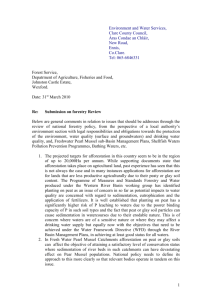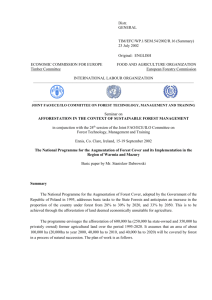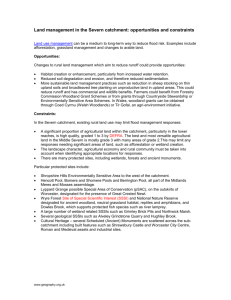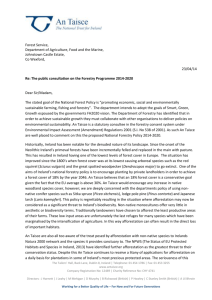Afforestation in Developing Countries as a Global Warming Remedy
advertisement
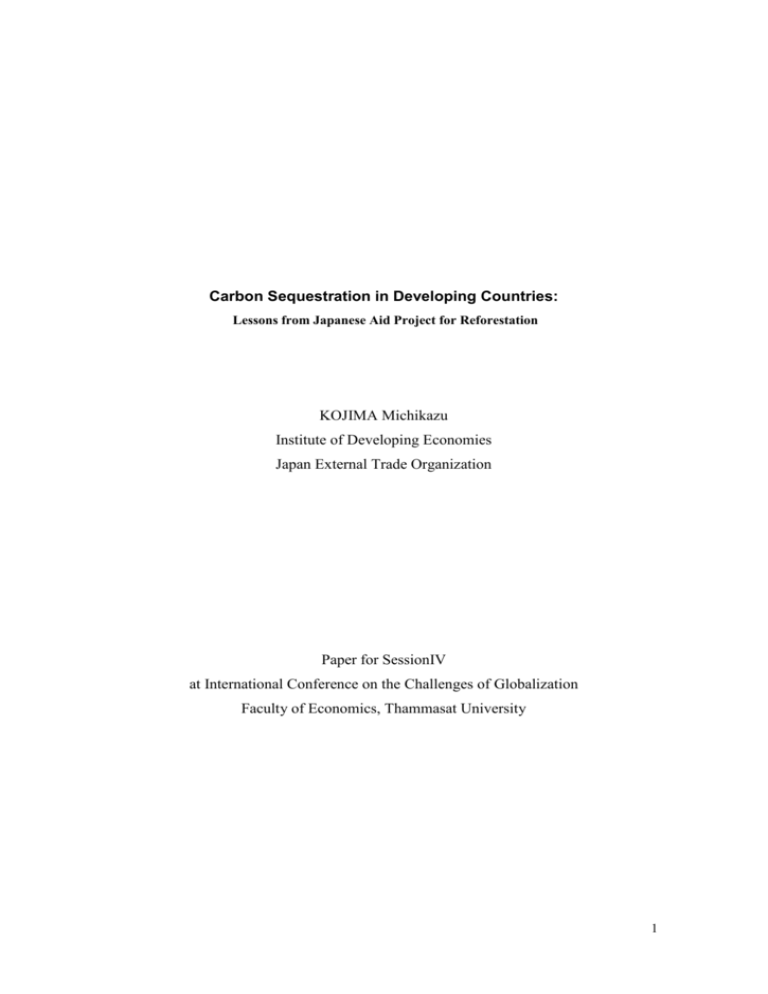
Carbon Sequestration in Developing Countries: Lessons from Japanese Aid Project for Reforestation KOJIMA Michikazu Institute of Developing Economies Japan External Trade Organization Paper for SessionIV at International Conference on the Challenges of Globalization Faculty of Economics, Thammasat University 1 1. Introduction There are hopes for the absorption of carbon dioxide by afforestation as a means of mitigating global warming. Forests absorb CO2, and even after trees are cut they will store carbon for decades if used as building materials. Using wood as biomass energy allows a reduction in the use of oil and other fossil fuels. Afforestation and subsequent uses of wood make it possible to slow the pace of global warming. Because afforestation costs less than energy conservation and other methods, it generates expectations as one way of coping with global warming. Additionally, it is believed that planting trees in developing countries will cost less and provide larger areas for afforestation than in developed countries. Accordingly, having developed countries fund afforestation in developing countries is regarded as a part of efforts to reduce CO2 emissions. But afforestation still does not have a clearly defined place in joint implementation (JI) and the clean development mechanism (CDM). The IPCC has been asked to evaluate afforestation as a carbon sink, and it is also under continuing consideration to determine a specific framework in the CDM. Meanwhile, a number of forest conservation and afforestation projects are underway as pilot phase projects for activities implemented jointly (AIJ). At the fourth FCCC Conference of the Parties held in Buenos Aires, there were reports on 95 projects as AIJ, 12 of which were forest conservation and afforestation projects. Forest conservation/recovery and afforestation projects account for 12.6% of the total number of projects, while in terms of GHG reduction and absorption they account for 52.2% (Table 1). Note, however, that the national park project implemented jointly by the U.S. and Costa Rica makes a very large contribution, with this project alone accounting for 35.5% of total reduction and absorption. And although not AIJ officially authorized by partner countries, Japanese NGOs and businesses are conducting afforestation activities in China and Indonesia in an effort to become AIJ. Since even before afforestation was conducted as a global warming remedy, developed countries had cooperated with afforestation in developing countries as part of their official development assistance. Under several projects inadequate consideration for local inhabitants led them to carry out grassland burnoffs and other acts that resulted in damage to afforested areas. In order to avoid such problems, forestry aid by developed countries and international organizations now attaches greater importance to 2 how local inhabitants are affected by projects. Afforestation to deal with global warming emerged from the dissociation with this history of improvement in forestry projects. If large-scale afforestation is conducted to control global warming while ignoring the lessons of the past, it is possible that past problems will recur. In this paper I will review the afforestation experiences of the Japan International Cooperation Agency (JICA) and other organizations, and determine what cautions need to be observed with afforestation meant to control global warming. 2. Conflict with Local People in Afforestation A lot of afforestation project have been conducted in developing countries in 1970s and 1980s. Afforestation has been carried out as a means to cope with ecosystem deterioration such as deforestation, desertification and soil erosion. Afforestation offers many merits for environmental conservation, but, in reality, afforestation projects often bring conflicts with local people. The first forestry project in developing countries assisted by Japanese Government was started in 1976 in Philippines. After that, forestry projects in Indonesia, Thailand and so forth are assisted by Japanese Government. Some afforestation projects in developing countries assisted by Japan International Cooperation Agency have had experiences of conflicts with local people (Table 2). In the Philippines, afforestation site in Pandapangan have been damaged by fire for livestock grazing of nearby community people. In 1983, 13 cases of fire damage 726 ha of the reforested area. In 1988, 19 cases of fire is occurred and 528ha was damaged. 15% of the total reforested area was damaged in this tow years. In the conservation forest project in South Sulawesi, Indonesia, 30% of planted trees were eaten by cattle. At this project site, the reforestation project had been conducted in 1963 and 1977. But the reforested area had been deforested by the activity of local people near the project site. The reason why this kind of conflicts has taken place is that the objective of reforestation is not compatible with the needs of the local people. In the case of South Sulawesi, the objectives of reforestation was to protect the lower-river-basin from flooding, and the needs of the people in the upper-river basin were not sufficiently taken 3 into account. 3. From Industrial Forestry to Social Forestry Recently an objectives of reforestation has changed and the needs of local people have been incorporated in the projects to avoid conflicts with them. Oya (1998) calls this kind of change a “paradigm shift” in forest policy. In Asia he says this is underway in India, Nepal, the Philippines, Thailand, and Indonesia. The JICA project at Pandabagan in the Philippines incorporated the perspective of social forestry in its second phase beginning in 1987. Similarly, beginning in 1981 an afforestation project in southern Sumatra established a demonstration forest in order to increase the practice of agroforestry among local people, and set up a program to have them actually experience agroforestry in afforested areas. A social forestry training program conducted by JICA in Kenya beginning in 1985 built and supports self-reliant afforestation activities among local people by building a seedling center, instructing technical experts involved in social forestry, and training local people. World Bank forestry sector aid has also put more emphasis on social forestry. In monetary terms, social forestry projects accounted for a mere 3.7% of all forestryrelated projects cumulatively from 1949 to 1978, but that proportion attained 42.0% from 1979 to 1990 (Table 3). Nearly 50% of all projects are social forestry projects. Even in projects designed as pilot phases of AIJ meant to cope with global warming, there are now efforts at incorporating a social forestry perspective. In test afforestation conducted by the Sumitomo Forestry Co., Ltd. on Indonesia's Kalimantan, activities in cooperation with farmers include the planting of fruit trees such as durian, mango, and ranbutan. Additionally, afforestation conducted by the Global Afforestation Center in China's Harasa Desert takes the needs of local people into consideration by creating pastureland in addition to planting poplar and other trees. This does not mean, however, that all social forestry projects are proceeding smoothly. For example, Seki (1996) points out that even in the third year after planting carried out in "Forestry Sector Project" contracted afforestation in the Philippines, financed by OECF and ADB, project assessment results led to judgments that planters had failed to observe their contractual obligations. Of 928 operations comprising 22,400 ha in the central Luzon region, cancellations for breach of contract came to 4 65.8% by number of operations and 71.0% in terms of area. As one cause of failure Seki (1996) notes that because afforested areas are returned to the government after the three-year contract period ends, local people have little incentive to manage the afforested areas, which readily allows the occurrence of bush fires. [1] Tamale et. al.(1995) pointed out the following reasons for the failure of social forestry projects. (1) Lack of land tenure security. (2) Lack of control over forest resources. (3) Lack of secure or reliable markets and suitable pricing policies. (4) Lack of appropriate technologies. (5) Long rotation periods (6) Competition with other land uses for land, labor and capital. (7) Bureaucratic adamancy. (8) Weak local institutional capacity. Note that most points are associated with social and institutional factors. It is conceivable that limitations will be placed on the use of trees and forest resources grown in projects under JI and the CDM that give developed countries credits for cutting CO2 emissions. It is also possible that primarily fast-growing tree species will be chosen. This is related to item 2) in the foregoing list and could be a cause of failure. It is also conceivable that in remote areas the high cost of transporting forest products to market will discourage local people from afforestation. When carrying out social forestry as a global warming abatement measure care must be exercised so as to learn from past experiences and take social and institutional factors into consideration. 4. Cautions to Be Observed in Afforestation to Abate Global Warming While many people including those in the developed countries will equally enjoy the benefits of afforestation meant to control global warming, people who live near afforested areas do not have a big incentive to protect those areas. Pursuing afforestation with only the control of global warming in mind could run counter to the paradigm shift that has heretofore occurred in the forestry sector, and damage to 5 afforested areas is anticipated. Below I shall individually discuss three aspects of the cautions necessary with regard to afforestation to abate global warming: Actual afforestation activities, estimation of CO2 absorption by afforestation and its cost, and the place of such afforestation within CDM and other frameworks. 4-1. Afforestation Activities As stated previously, some of the afforestation being carried out by Japanese organizations in hopes of becoming AIJ pilot-phase projects take into account the effects on local people. But a few afforested areas have been damaged by forest fires. It is possible that businesses and other organizations with little afforestation experience in developing countries will discount impacts on local people when afforesting large areas as a means of countering global warming. Thus caution is advised. Large-scale afforestation in areas where land use rights and the like are illdefined is perhaps best avoided. Priority for afforestation to control global warming should go to afforestation meant for areas with comparatively low populations and good availability of water, and to social forestry that encourages spontaneous afforestation by farmers. In those instances as well, adequate assessments of impacts on social environments should be conducted, and afforestation should be carried out by taking into account such factors as the rights of local people. Care is also required in the selection of tree species. Although abatement of global warming favors fast-growing species, it is necessary to also take the needs of local people into consideration when choosing species. One must not forget that afforestation will function to alleviate global warming only with the coexistence of local people with the forest. 4-2. Estimation of CO2 Absorption by Afforestation and Its Cost Mitigation of global warming requires that we control the amounts of CO2 emissions and absorption for the globe as a whole. It is also necessary to minimize the costs of reducing and abating emissions while keeping equity in mind. With afforestation as well one must provide information on the absorption amount and cost, and compare this with the same information for energy conservation and other means of reducing CO2 emissions. 6 Heretofore afforestation costs for mitigating global warming have been estimated on the basis of expenses incurred in the afforestation operation itself, such as the cost of seedlings and personnel costs like planting seedlings and cutting undergrowth. Estimates must also include social costs such as opportunity cost incurred because local people can no longer use the forest. It is very possible that local people use forests as places for swidden fields, grazing livestock, or gathering fuelwood. As the income of local people will likely fall if they are no longer able to use forest lands, one has to consider compensation. If one ignores the livelihoods of the local people and places guards around the forests to protect them, that cost must also be added to those of global warming abatement. If the local people are forced out, however, even if they are given a measure of monetary compensation, those who have no means of livelihood except opening up the forest for agriculture will likely move into areas of the forest where management is lacking. It is also possible that deforestation will occur in places other than afforested areas. Moreover, it is conceivable that if afforested areas are not managed properly, they will be reduced through burnoffs and other acts. It is necessary to also determine impacts like these. IPCC WG III (1996) in Chapter 7 advises caution so that afforestation does not diverge from the needs of local people. But the connections with local people are not adequately reflected in, for instance, the estimates of afforestation costs and the size of areas to be planted. More accurate determination of the latent effectiveness of afforestation requires more detailed studies of the social and economic circumstances of areas where afforestation is thought to be possible to determine afforestation costs and the sizes of the areas that can be planted. If one ignores social and economic circumstances, one may overestimate the effectiveness of CO2 absorption by afforestation, or underestimate costs. 4-3. Cautions Needed for Application within the CDM Framework FCCC conferences of the parties are henceforth to discuss the matter of how to add the CO2 reduction achieved in developing countries through CDMs and other means to the emission reduction credits of developed countries that provide the funding. Additionally, some decisions have yet to be made about the treatment of forests and other carbon sinks in the developed countries. What have we learned from afforestation 7 experiences thus far that is applicable to future rule-making? When the effects of afforestation are treated as credits for CO2 emission reductions, factors such as loss of forests and their insufficient growth need to be taken into account. For example, in the event that a forest is lost after certification of its CO2 emission reduction, how should this be reflected in the emission reduction amount of developed countries? If such an event does not affect credits, afforested areas will be protected from spreading fires while tree growth is fast, but there will be no incentive to protect forests whose growth has slowed. Necessary are arrangements which will ensure that credits will change in accordance with how an afforested area is managed. Additionally, because it is possible that local people who have lost the use of afforested land will open other forests, the impacts of this need to be taken into consideration. [2] The IPCC is to deliberate on the treatment of sinks, and one hopes that as part of that deliberation the impacts on local people are given proper consideration. 5. Summation When deciding on the specifics of afforestation projects and the like, developing country governments do not necessarily take into consideration the benefits to local people in areas slated for forest conservation or afforestation. It is also possible that they will put efforts into large-scale afforestation to abate global warming, for which funding is easily acquired, but see no importance in social forestry, which brings about benefits for local people. Developed countries too must exercise adequate care to see that this does not happen. It is observed that CO2 emission cuts in the energy sector by conservation and other means have the double dividend of reducing other pollutants such as sulfur oxides. Similarly, afforestation can provide double or triple dividends by absorbing CO2, improving the livelihoods of local people, and, over larger geographic areas, forestland conservation and flood control. It is necessary to proceed carefully with afforestation after having ascertained the social and economic circumstances in the area to be planted. [1] Seki (December 1996) describes contract afforestation in contrast with the Integrated Social Forestry Program legislated in 1982, but based on Westby's 8 (1989) definition, contract afforestation too is a form of social forestry in that local people are contracted to perform afforestation. [2] This can be seen as a problem of implementing the CDM without being able to put caps on GHG emissions in developing countries. References: Bruce, James P., Hoesung Lee and Erik F. Haites(ed), Climate Change 1995: Economic and Social Dimensions of Climate Change, Cambridge University Press, 1996 Fujimura, Takashi, Hinkon, Yama-kaji, NPA no hazamade (Between Poverty, Forest Fire and NPA), Ringyou-keizai-shinbun, 1986. Inoue, Makoto, ”Makassar jin no sanson ni okeru bunka-seitaikei no doutai”(Dynamics of Cultural Ecosystems in the Makassr Mountainous Region), Southeast Asian Studies.Vol.33, No.2, pp.224244, 1995. Kojima, Michikazu and Michio Watanabe, “Development Issues in Developing Countries: Approach toward Sustainable Development in Rural Areas in Developing Countiries”, in Mori et.al. Society in 2050: Choice for Global Sustainability, The Asahi Glass Foundation, 1998. Oya, Kenji, “Shinrin/Rinya no chiiki shakai kanri: Laos niokeru tochi/rinya haibunn jigyou no kanousei to kadai” (Rural Community Management to Forest and Forested Land: The Possibility and Obstacles of Destribution Projects of Land and Forest in Laos), in Society for Environmental Economics and Policy(ed.), Asia no kankyo mondai, (Environmental Issues in Asia), Toyo Keizai Shinpo sha, 1998. Secretariat of Framework Convention on Climate Change, “Review of the Implementation of Commitments and of Other Provisions of the Convention: Activities Implemented Jointly: Review of Progress under the Pilot Phase (Decision 5/CP. 1)”, FCCC/CP/1998/2, 1998. Seki, Yoshiki, “Philippines ni okeru juuminsankagata no zourin: chuubu Luzon ni okeru 2tsu no sonraku no jirei wo tooshite”(Reforestation based on participatory approach in the Philippines - Case Studies of two villages in Central Luzon.), Ninhon-ringakkai-ronbunshuu, Vol. 107, pp.9-12, 1996. Tamale, Eric, Norman Jones and Idah Pswarayi-Riddihough, Technologies Related to Participatory Forestry in Tropical Forestry in Tropical and Subtropical Countries, World Bank Technical Paper No. 289, World Bank, 1995 Westoby, Jack, Introduction to World Forestry: People and their Trees, B. Blackwell, 1989 World Bank, Forestry: The World Bank’s Experience, 1991 Table 1. 9 Numbers of AIJ projects and GHG impacts by activity type during project life time. Activity Type Number of GHG impact projects Average GHG Impacts Forest Preservation, Reforestation, Restoration 11 84,322,571 7,665,688 Afforestation 1 292,728 292,728 Agriculture 2 3,065,770 1,532,885 Fuel switching 3 3,023,416 1,007,805 Fugitive Gas Capture 2 30,007,966 15,003,983 Energy Efficiency 36 7,773,939 215,943 Renewable Energy 40 33,183,262 829,582 Total 95 161,669,652 1,701,786 Source: Secretariat of Framework Convention on Climate Change(1998) 10 Table 2. Conflicts with Local People in Reforestation Projects by JICA Project Period Objective Conflicts with local farmers Afforestation Project June 18, Development of reforestation Reforestation area has been in Pantabangan 1976 – techniques and training burned due to nearby fire for (Philippines) July 23, through the reforestation of shifting cultivation and grazing 1992 8,100 ha pilot forests. It amounted to 726 ha in 1983 and 528 ha in 1988. Afforestation Project April 12, Training of reforestation Fields around the project site in Benakat, South 1979 – technology by creating 2,100 are often burned by farmers for Sumatra. March ha Pilot forest at slash-and creating grazing land. (Indonesia) 31, 1988 burnt area and agroforestry to settle farmers that engage in shifting cultivation. Watershed July 21, In order to develop Reforestation has been carried Management 1988 – watershed management out on the tract of 785 ha. But Technology Project in July 20, techniques of hydro-regime, 30% of trees have been eaten South Sulawesi 1993 reforestation is conducted. by cattle grazed. (Indonesia) Source: Pamphlet and reports by JICA, Fujimura(1986) and Inoue(1995). 11 Table 3. World Bank Lending by Type of Forestry, 1949-1990 1949- 1978 1979- 1990 Number of Lending Number of Lending Operations Commitments Operations Commitments (US$ Millions) (Us$ Millions) Social Forestry 2 11.18 36 915.86 19 294.70 26 894.50 0 0.00 11 369.70 Industrial/Mgmt/Saw mills/Logging Environmantal/Wate rshed Mgmt Source: World Bank(1991) 12
